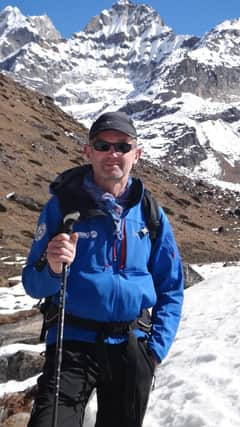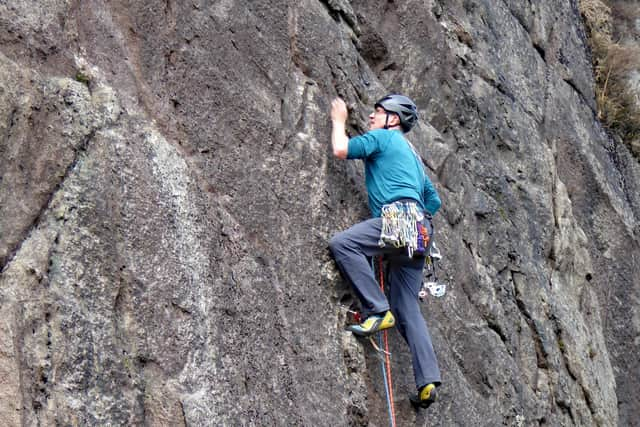Life after stroke is a new mountain to climb for Everest legend Dawson Stelfox


But, unfortunately, this time last year, the well-known climber and architect had an unexpected, life-changing stroke at the age of just 64.
Dawson said: “I've always been generally pretty fit and healthy from being a regular hill walker and rock climber. I had actually been out in the Mournes two days before the first symptoms of my stroke started.
Advertisement
Hide AdAdvertisement
Hide Ad“I woke up one morning at 5am and I was totally numb down my left-hand side. I immediately thought I was experiencing a TIA, often known as a ‘mini stroke’, and my wife took me to the Royal Victoria Hospital. We were probably at the hospital within 40 minutes of my symptoms beginning but by that time the feeling of numbness was starting to wear off. When the medical team examined me, they immediately picked up that I had very high blood pressure. I had a CT scan, was prescribed medication to reduce my blood pressure and thin my blood and was sent home.”However, Dawson experienced a series of similar incidents over the next few days.


“The same thing happened the next day, so I went back to the hospital but, again, by the time I was having an MRI scan the numbness symptoms were going. Again, I was checked out and sent home. The third time it happened I was kept in hospital overnight and again the symptoms seemed to diminish, and I was sent home. The fourth time it happened however the symptoms did not diminish or go away.”
The medical team at the Royal did various scans and tests and they diagnosed Capsular Warning Syndrome.
"What I was experiencing wasn’t a clot or bleed as such, it was a spasm in a blood vessel in my brain. It was going into spasm because of the high blood pressure, causing the feeling of numbness, but then it was releasing which is why the symptoms were going away at times. Eventually the blood vessel went into a spasm that blocked it completely which stopped the blood supply to my brain.”Unfortunately Dawson’s stroke resulted in part of his brain being deprived of oxygen and subsequently dying.
Advertisement
Hide AdAdvertisement
Hide Ad“It affected my whole left-hand side, my left leg, left arm, a little in my face. I never lost my speech completely, but it was a bit slurred and even now when I'm tired my face muscles weaken. Broadly speaking my speech and memory weren’t affected but physically I was pretty much immobile down my left side.”
Dawson spent one month in the Royal Victoria Hospital’s stroke ward and has been gradually recovering since being discharged in February. He had physiotherapy and occupational therapy through the Community Stroke Team at the Lagan Valley Hospital, and it was they who pointed him in the direction of Northern Ireland Chest Heart and Stroke for further support.
“I attended two sets of NICHS’s Post Rehab Exercise Programme (PREP) which involves a combination of education and physio-developed exercises.
“What is good and different about PREP is that you are measuring yourself against time on the activities. If you have any sort of competitive spirit, like I do, you are always trying to do a bit better than the previous week. It’s not about competing with other people in the group, it’s about challenging yourself and what you can do. There is a sort of parallel to climbing and mountaineering activities in the sense that with these, you are not in competition with the other people that you are climbing with, you are in competition with the environment that you are in.”
Advertisement
Hide AdAdvertisement
Hide AdLike many stroke survivors, Dawson found the effects of his stroke turned his world upside down. “The stroke was a huge shock to my system after always being so active. The sudden loss of capacity takes a lot of getting used to. I have a strong, determined mindset however and that definitely helps. It is a long, slow process but the good thing is you do see progress.
“Now, I am still working with the Community Stroke Team, and I go to the gym and I’m gradually recovering. I haven’t quite fully recovered on the left side, but I can walk reasonable distances quite slowly- the furthest I have walked is four miles. I have been out walking on some roughish tracks and I’ve actually been rock climbing again on an indoor wall. I’m gradually getting my strength and coordination back- I still have quite a way to go but I’m determined to get there.”
Someone who shares a determined and ambitious nature with Dawson is Jackie Trainor, director of Income Generation at Northern Ireland Chest Heart & Stroke. Jackie is currently preparing to take on the gruelling challenge of trekking to Everest Base Camp with her husband Conor, all in aid of raising much needed funds for the charity.
Jackie said: The money raised from my trek will help deliver programmes like the PREP group Dawson attended, as well as support the expansion of our cardiac support services in line with our new strategy to help people across NI impacted by heart illness.
Advertisement
Hide AdAdvertisement
Hide AdIf you have been affected by a chest, heart or stroke condition and need support visit nichs.org.uk/care-and-support for further information about NICHS’s support services.
If you would like to support Jackie’s fundraising efforts, visit www.justgiving.com/page/jackie-trainor-16975723
Comment Guidelines
National World encourages reader discussion on our stories. User feedback, insights and back-and-forth exchanges add a rich layer of context to reporting. Please review our Community Guidelines before commenting.